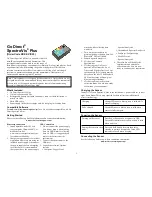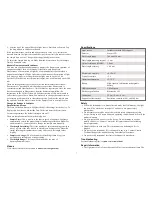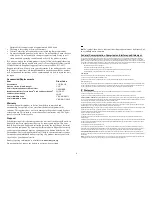
6
6. Place your second standard sample in the Spectrophotometer. After the
absorbance readings stabilize, tap Keep. Enter the concentration of the
second sample and select OK.
7. Repeat Step 5 for the remaining standard samples. After you have tested the
final standard, tap the Stop button to end data collection.
8. To calculate a best fit line equation for your standards, choose Curve Fit
from the Analyze menu. Select Linear for the Fit Equation, and then select
OK. The graph screen will appear again with the linear regression equation
displayed.
9. Place a cuvette containing an unknown sample of solution in the
Spectrophotometer. Tap the Meter tab and write down the displayed
absorbance value. Tap the Graph tab and choose Interpolate from the
Analyze menu. Trace the linear regression equation to determine the
concentration of the unknown.
Measurement
vs.
Time (Kinetics)
1. Generate a spectrum as described above. On the Meter screen, tap Mode.
Change the data-collection mode to Time Based.
2. You can change the rate, interval, and/or duration of time of data collection,
if desired. Select OK when you are ready to proceed.
3. A message will appear warning you to either save or discard the full
spectrum run. Make your choice and proceed with data collection.
4. Set the wavelength for data collection. On the Meter screen, tap on the
meter, and select Change Wavelength. Enter the wavelength of your choice
and select OK. If the wavelength you type in is not measured by the unit,
LabQuest will automatically choose the wavelength closest to your choice.
5. Mix the reactants, transfer ~2 mL of the reaction mixture to a cuvette, and
place the cuvette in the Spectrophotometer. Start data collection. You may
tap the Stop button to end data collection early.
6. To calculate a function for your data, choose Curve Fit from the Analyze
menu. Select the Fit Equation, and then select OK. The graph screen will
appear again.
Measure an Emission Spectrum with LabQuest
You may use your Spectrophotometer to measure the emission spectrum of a
light source such as an LED or a gas discharge tube. To do so, you will need to
purchase the Vernier Optical Fiber (order code: VSP-FIBER).
Note:
For best
results observing emission spectra, consider the Vernier Emission Spectrometer
(order code: VSP-EM).
Measure Intensity of Light Emissions
1. Insert the Vernier Optical Fiber into the SpectroVis Plus.
2. Use a USB cable to connect the Spectrophotometer to your LabQuest.
3. Choose New from the File menu.
4. On the Meter screen, tap Change Units ► USB: Spectrophotometer ►
Intensity from the Sensors menu. Intensity is a relative measure with a range
of 0–1.
Note:
The Spectrophotometer is not calibrated for measuring
intensity.
Using the Product with LabQuest App
Select the Type of Data (or Units) You Want to Measure
The default data type is absorbance. If you want to measure the absorbance of a
solution, proceed directly to the Calibrate section.
If you want to measure %T, fluorescence (excited at 405 nm or 500 nm), or
intensity, do the following:
1. From the Sensors menu, choose Change Units ► USB: Spectrophotometer.
2. Select the unit or data type you wish to measure.
Calibrate the Spectrophotometer (Not Required if Measuring Intensity or
Fluorescence)
1. Choose Calibrate ► USB: Spectrophotometer from the Sensors menu.
Note:
For best results, allow the Spectrophotometer to warm up for a minimum of
five minutes.
2. Fill a cuvette about 3/4 full with distilled water (or the solvent being used
in the experiment) to serve as the blank. After the Spectrophotometer has
warmed up, place the blank cuvette in the Spectrophotometer. Align the
cuvette so a clear side of the cuvette is facing the light source.
3. Follow the instructions in the dialog box to complete the calibration, and
then tap OK.
Collect Data with LabQuest
Measurement
vs.
Wavelength (Generate a Spectrum)
1. Fill a cuvette about 3/4 full of the solution to be tested and place it in the
Spectrophotometer.
2. Start data collection by tapping on the Start button in the lower left corner
of the screen. Tap the Stop button to end data collection.
3. Tap on the graph to select a wavelength. Note the wavelength you may
want to use for a future Beer's law or kinetics experiment.
4. To store the spectrum data, tap on the file cabinet icon in the upper right of
your screen.
Measurement
vs.
Concentration (Beer’s Law Studies)
1. Generate a spectrum as described above. On the Meter screen, tap Mode.
Change the mode to Events with Entry.
2. Enter the Name (e.g., Concentration) and Units (e.g., mol/L). Select OK.
3. A message will appear warning you to either save or discard the full
spectrum run. Make your choice and proceed with data collection.
4. Set the wavelength for data collection. On the Meter screen, tap on the
meter, and select Change Wavelength. Enter the wavelength of your choice
and select OK. If the wavelength you type in is not measured by the unit,
LabQuest will automatically choose the wavelength closest to your choice.
5. Place your first Beer’s law standard solution in the Spectrophotometer. Start
data collection. After the absorbance reading stabilizes, tap Keep. Enter the
concentration of the solution and select OK.



























